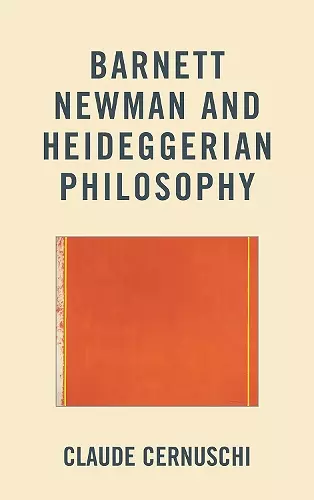Barnett Newman and Heideggerian Philosophy
Format:Hardback
Publisher:Associated University Presses
Published:22nd Mar '12
Currently unavailable, and unfortunately no date known when it will be back

As a major member of the New York School, Barnett Newman is celebrated for his radical explorations of color and scale and, as a precursor to the Minimalist movement, for his significant contribution to the development of twentieth-century American art. But if his reputation and place in history have grown progressively more secure, the work he produced remains highly resistant to interpretation. His paintings are rigorously abstract, and his writings full of references to arcane metaphysical concepts. Frustrated over their inability to reconcile the works with what the artist said about them, some critics have dismissed the paintings as impenetrable. The art historian Yve-Alain Bois called Newman “the most difficult artist” he could name, and the philosopher Jean-François Lyotard declared that “there is almost nothing to ‘consume’ [in his work], or if there is, I do not know what it is.”
In order to advance interpretation, this book investigates both Newman’s writings and paintings in light of ideas articulated by one of Germany’s most important and influential philosophers: Martin Heidegger. Many of the themes explored in Newman’s statements, and echoed in the titles of his paintings, betray numerous points of intersection with Heidegger’s philosophy: the question of origins, the distinctiveness of human presence, a person’s sense of place, the sensation of terror, the definition of freedom, the importance of mood to existence, the particularities of art and language, the impact of technology on modern life, the meaning of time, and the human being’s relationship to others and to the divine. When examined in the context of Heideggerian thought, these issues acquire greater concreteness, and, in turn, their relation to the artist’s paintings becomes clearer. It is the contention of this book that, at the intersection of art history and philosophy, an interdisciplinary framework emerges wherein the artist’s broader motivations and the specific meanings of his paintings prove more amenable to elucidation.
Viewers who have acknowledged the demands that Newman’s art places on them cannot fail, when they become readers of this book, to appreciate Claude Cernuschi’s accomplishment in philosophically interpreting the artist’s works and ideas. Reaching beyond the disciplinary boundaries of art history narrowly construed, Cernuschi provides a rewarding assessment of the Heideggerian resonance of Newman’s thought, and ultimately clears a path to a greater understanding of the meaning and significance of his art. -- Michael Schreyach, Trinity University
With the scrupulous attention to detail and brisk writing style that characterizes Claude Cernuschi's work, his new study probes intriguing correspondences between Martin Heidegger's articulation of philosophical principles and Barnett Newman's articulation of aesthetic experience. Cernuschi demonstrates that the two thinkers shared numerous concepts and metaphors. To follow him through the maze of his investigation is to observe philosophy becoming aesthetics and aesthetics becoming philosophy. This fascinating convergence may well have pleased both Heidegger and Newman. -- Richard Shiff, Professor, The University of Texas at Austin
ISBN: 9781611475197
Dimensions: 235mm x 160mm x 27mm
Weight: 721g
348 pages